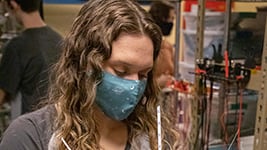On Tuesday, the first satellite built in Oregon launched into space from Kodiak, Alaska. It was enveloped in a rocket. Nine minutes later, when the rocket reached the top of its flight at orbit going 17,000 miles per hour, a little door opened in the rocket and the 10-by-10-centimeter Portland-made satellite shot out into space.
That satellite was built from scratch by Portland State University students who are part of the school’s Aerospace Society, which is a volunteer group that includes business, electrical engineering, graphic design, chemistry and computer design students.
Andrew Greenberg, the group’s faculty adviser, says the group began building its own satellite five years ago when it got accepted into a NASA program that offered to fly small satellites of this kind, called a CubeSat, for free.
“We were like, oh my God, we get a free ride to space! So we started to build our satellite,” says Greenberg. “We promised to build our own satellite, which is a crazy-ass thing to promise in a couple of years. Most people buy the parts of the satellite off the shelf. But that was going to cost us $50,000 to $70,000 to buy stuff off the shelf, and we don’t have that budget, we’re crowdsourced.”
More than two dozen students worked on the project for five years.
Kathleen Joslyn, now a 27-year-old graduate who majored in math and taught herself orbital dynamics, was one of the engineers who designed the satellite. She informed the team about how the satellite would move through space and the hazards that could cause its early demise like extreme hot and cold temperatures, running into a meteor, flying rocks and excessive radiation from the sun.
“Space is dangerous. Lot of things that can go wrong. First, you could blow up on the launchpad, that would suck. We were very happy that didn’t happen,” says Joslyn. “Then you can blow up in the air, that would also suck. When you get up into space, there’s a chance you’re not deployed correctly. When you’re in orbit, possibility that your actual satellite can’t handle the temperature shifts of space.”
So far, the satellite is acting as it should: Whipping around the planet at 17,000 miles an hour in a stable orbit.
Its PSU builders are monitoring its health, which Greenberg says is “flawless, which is kind of astounding.” Its orbit is slowly decaying, but that’s intentional.
“We don’t want to be space junk in a thousand years,” says Greenberg. “In four years, we’ll become Oregon’s first meteor shower.” (Greenberg says it’s highly unlikely we’ll get to see that meteor shower.)
The group also designed a kit that allows anyone to build this particular type of satellite, and it’s already published. There are only three places domestically that are safe to launch a rocket that won’t endanger anyone: Kodiak; a tiny island in the Pacific Ocean; and Cape Canaveral, Fla.
When WW spoke with Greenberg, he said PSU’s tracking mechanism showed that the satellite was above Belize. Thirty seconds later, it was above Guatemala.
